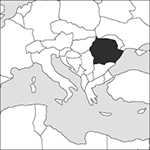
Source: MAPS IN MINUTES™ © RH Publications (1997)
Capital:
Bucharest
Area:
238,391 sq km (92,043 sq miles)
Population:
21,790,479 (2013 est)
Currency:
1 new leu = 100 bani
Religions:
Eastern Orthodox 81.9%; Protestant 6.4%; Roman Catholic 4.3%
Ethnic Groups:
Romanian 83.4%; Hungarian 6.3%; Romany 1.2%
Languages:
Romanian (official); Hungarian; Romany
International Organizations:
UN; OSCE; Council of Europe; NATO; WTO; EU
An east European country with its east coast on the Black Sea; it is bounded by Ukraine and the republic of Moldova on the north and east, Hungary and Serbia on the west, and Bulgaria on the south.
Physical
Roughly half of Romania is mountainous. The Carpathians, curving from the north-west, meet the Transylvanian Alps in the centre of the country, where rainfall is heavy and there are large forests. The rest of the country is plain, much of it providing the richest soil in Europe. The Danube forms the southern border as it flows east to its delta on the Black Sea.
Economy
Romania emerged from the repressive communist regime of Nicolae Ceausescu in 1989 with obsolete and unsuitable industry and widespread poverty. Progress towards a market economy only quickened after 2000, being encouraged from 2004 by the requirements of EU membership. However, one-fifth of the population still lives in poverty. Agriculture employs over a quarter of the workforce; principal crops are cereals, sugar beet, sunflower seeds, potatoes, and grapes. Mineral resources include coal, iron ore, petroleum, and natural gas. The principal export industries are cars, vehicle parts, machinery, metals, textiles, footwear, chemicals, minerals, and fuels; agricultural products are also exported.
History
Although the regions known as Moldavia and Walachia were part of the Ottoman empire from the 15th century onwards, Turkish domination was increasingly challenged by both Russia and Austria. In 1812 Russia gained control of north-east Moldavia (present-day Moldova). During the next 40 years Romanian nationalism precipitated many insurrections against the Turks. Following the Crimean War, during which the region was occupied by Russia, Walachia and Moldavia proclaimed themselves independent principalities; in 1861 they united to form Romania, electing a local prince, Alexander Cuza, as ruler. On his deposition (1866) Prince Carol Hohenzollen-Sigmaringen was elected. At the Congress of Berlin independence was recognized, and Prince Carol crowned king as Carol I (1881–1914). His pro-German policy led in 1883 to Romania’s joining the Triple Alliance of 1882 (Germany, Austria, and Italy). In World War I Romania remained neutral until, in 1916, it joined the Allies. At the Versailles Peace Settlement the country was rewarded with the doubling of its territories, mainly by the addition of Transylvania from Hungary. Carol I was succeeded by Ferdinand I (1914–27) and then by Carol II (1930–40), who imposed a fascist regime. He was forced to cede much territory to the Axis powers in 1940. Romanian forces cooperated with the German armies in their offensives (1941–42), but after the Battle of Stalingrad the Red Army advanced and Romania lost territory to the USSR and Bulgaria. A communist regime was established in 1948 and for the next 20 years the country became a Soviet satellite. A much greater degree of independence was restored during the presidency of Nicolae Ceausescu (1967–89), whose rule became increasingly brutal and autocratic. Stringent economic measures had to be enforced in 1987. During 1989 a movement towards democracy culminated in a violent revolution and the execution of the President and his wife on Christmas Day. A National Salvation Front (NSF) was formed, led by Ion Iliescu, who was elected President. He and many of his colleagues had been communists, and popular demonstrations against the government were brutally put down. Ethnic violence against Hungarians in Transylvania and against the large indigenous gypsy population increased. In spite of opposition from groups such as the Democratic Convention of Romania (CDR), Iliescu retained power in the 1992 presidential election, having secured a $748 million IMF loan. In 1995 the Chamber of Deputies enacted a Mass Privatization law affecting over 3000 businesses. In 1996 Iliescu was defeated in presidential elections by the CDR candidate, Emil Constantinescu. Social unrest and attacks on ethnic minorities continued. Iliescu was again President from 2000 to 2004, when the centre-right Traian Basescu was elected to succeed him. Romania joined NATO in 2004 and the EU in 2007. Basescu survived an attempted impeachment in 2007 and in 2009 was re-elected in a close-fought election. Following the Credit Crunch Romania negotiated a bailout loan from the EU, IMF, and World Bank in 2009 to support its faltering economy (a second loan facility was agreed in 2011 but not used). The loans’ terms required austerity measures and privatizations; these increased political instability, with popular protests and another failed impeachment of Basescu in 2012. The government fell in 2012 to be replaced by a coalition of technocrats and parties from the Social Liberal Union led by Victor Ponta. Klaus Iohannis of the National Liberal Party beat Ponta in presidential elections in late 2014. Ponta resigned as Prime Minister in 2015 after a nightclub fire caused many deaths leading to protests about government corruption and poor safety regulations. The President replaced him with the technocrat and former EU agriculture commissioner Dacian Ciolos. The Social Liberal Union returned to power after elections in late 2016, and Sorin Grindeanu became Prime Minister. He reversed a decision to reduce some penalties for corruption after demonstrations that were the largest since 1989.
- van’t Hoff, Jacobus Henricus (1852–1911)
- van’t Hoff’s isochore
- vaporization
- vapour
- vapour-absorption cycle
- vapour cloud explosion
- vapour-compression cycle
- vapour density
- vapour-phase crystallization
- vapour phase epitaxy
- vapour plating
- vapour pressure
- vapour-pressure curve
- vapour recovery unit
- vapour–liquid equilibria
- vapour–liquid separator
- VAR
- VaR
- Var
- var
- varactor
- varactor tuning
- Varadhan, Sathamangalam Ranga Srinivasa ‘Raghu’ (1940– )
- Varanger
- Varangian